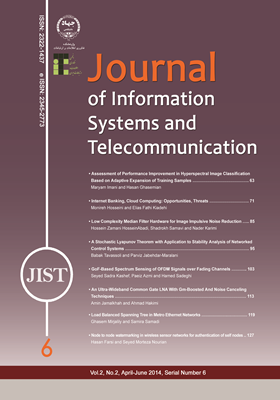-
-
List of Articles
-
Open Access Article
1 - Assessment of Performance Improvement in Hyperspectral Image Classification Based on Adaptive Expansion of Training Samples
Maryam Imani -
Open Access Article
2 - Internet Banking, Cloud Computing: Opportunities, Threats
Monireh Hosseini Elias Fathi Kiadehi -
Open Access Article
3 - Low Complexity Median Filter Hardware for Image Impulsive Noise Reduction
Hossein Zamani HosseinAbadi samavi96 samavi96 Nader Karimi -
Open Access Article
4 - A Stochastic Lyapunov Theorem with Application to Stability Analysis of Networked Control Systems
Babak Tavassoli Parviz Jabehdar Maralani -
Open Access Article
5 - GoF-Based Spectrum Sensing of OFDM Signals over Fading Channels
Seyed Sadra Kashef paeez azmi Hamed Sadeghi -
Open Access Article
6 - An Ultra-Wideband Common Gate LNA With Gm-Boosted And Noise Canceling Techniques
Amin Jamalkhah Ahmad Hakimi -
Open Access Article
7 - Load Balanced Spanning Tree in Metro Ethernet Networks
Ghasem Mirjalily Samira Samadi -
Open Access Article
8 - Node to Node Watermarking in Wireless Sensor Networks for Authentication of Self Nodes
Hassan Farsi Seyed Morteza Nourian
-
The rights to this website are owned by the Raimag Press Management System.
Copyright © 2017-2025







